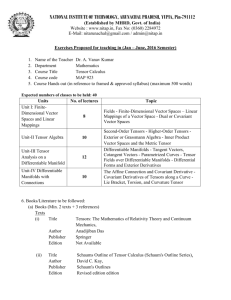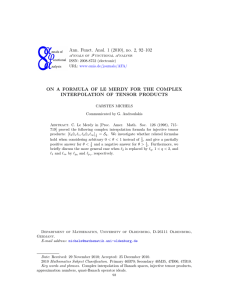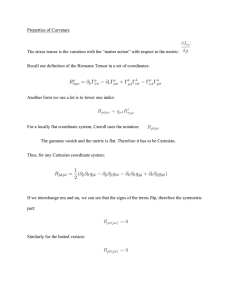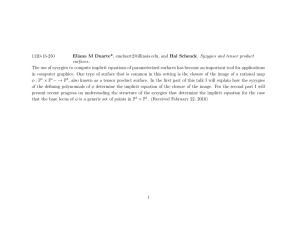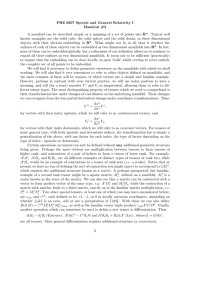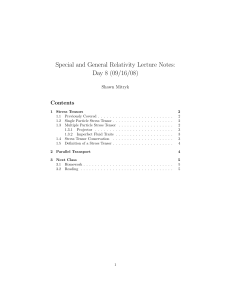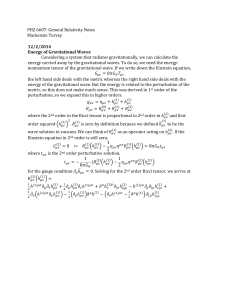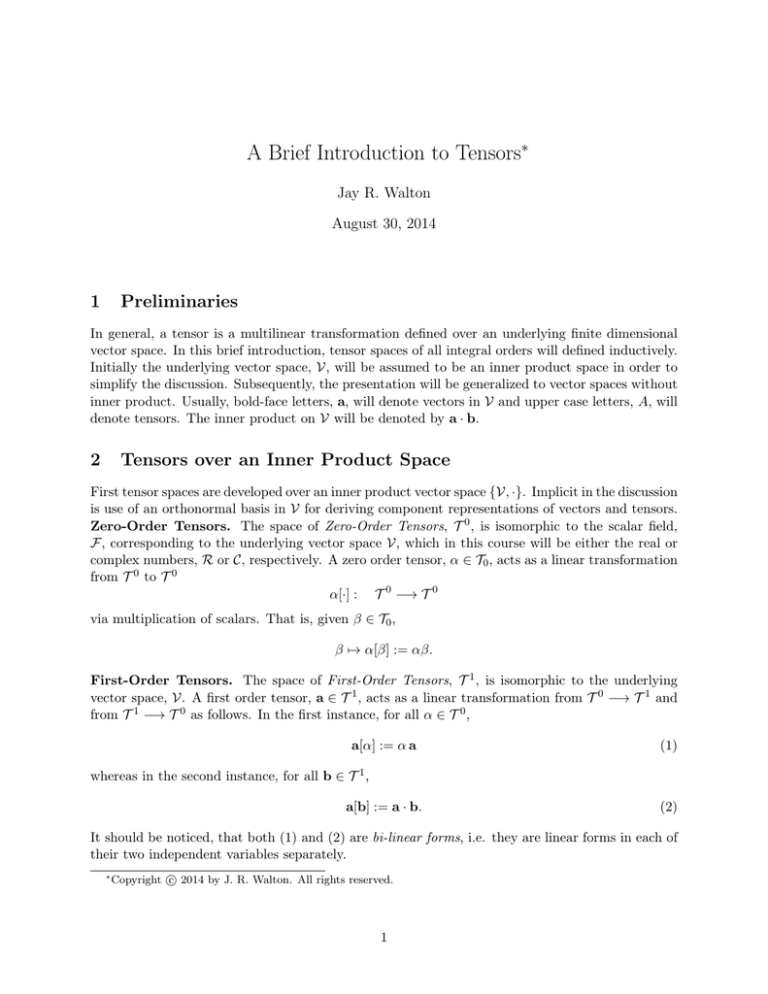
A Brief Introduction to Tensors∗
Jay R. Walton
August 30, 2014
1
Preliminaries
In general, a tensor is a multilinear transformation defined over an underlying finite dimensional
vector space. In this brief introduction, tensor spaces of all integral orders will defined inductively.
Initially the underlying vector space, V, will be assumed to be an inner product space in order to
simplify the discussion. Subsequently, the presentation will be generalized to vector spaces without
inner product. Usually, bold-face letters, a, will denote vectors in V and upper case letters, A, will
denote tensors. The inner product on V will be denoted by a · b.
2
Tensors over an Inner Product Space
First tensor spaces are developed over an inner product vector space {V, ·}. Implicit in the discussion
is use of an orthonormal basis in V for deriving component representations of vectors and tensors.
Zero-Order Tensors. The space of Zero-Order Tensors, T 0 , is isomorphic to the scalar field,
F, corresponding to the underlying vector space V, which in this course will be either the real or
complex numbers, R or C, respectively. A zero order tensor, α ∈ T0 , acts as a linear transformation
from T 0 to T 0
α[·] : T 0 −→ T 0
via multiplication of scalars. That is, given β ∈ T0 ,
β 7→ α[β] := αβ.
First-Order Tensors. The space of First-Order Tensors, T 1 , is isomorphic to the underlying
vector space, V. A first order tensor, a ∈ T 1 , acts as a linear transformation from T 0 −→ T 1 and
from T 1 −→ T 0 as follows. In the first instance, for all α ∈ T 0 ,
a[α] := α a
(1)
whereas in the second instance, for all b ∈ T 1 ,
a[b] := a · b.
(2)
It should be noticed, that both (1) and (2) are bi-linear forms, i.e. they are linear forms in each of
their two independent variables separately.
∗
c 2014 by J. R. Walton. All rights reserved.
Copyright 1
Second-Order Tensors. The space of Second-Order Tensors, T 2 , is isomorphic to the space,
Lin[V], of linear transformations A : V −→ V. Elements in T 2 act as linear transformations from
T i −→ T j with i, j = 0, 1, 2 subject to i + j = 2. For i = 0, j = 2 one has for A ∈ T 2 and α ∈ T 0
A[α] := α A.
(3)
For i = 1, j = 1, one has for A ∈ T 2 and a ∈ T 1
A[a] := Aa
(4)
where the expression of the right hand side of (4) denotes the action of the linear transformation
A ∈Lin[V] on the vector a ∈ V. For i = 2, j = 0, one has for A, B ∈ T 2
A[B] := A · B
(5)
where A · B denotes the natural inner product on Lin[V] defined by
A · B := tr[AT B].
(6)
In (6), tr[A] denotes the trace of A ∈Lin[V] and AT denotes the transpose of A.
Finally, a second-order tensor A ∈ T 2 can be used to define a bi-linear transformation on V.
Specifically, A[·, ·] : T 1 × T 1 −→ T 0 is defined by
ha, biA := a · (A[b])
(7)
for all a, b ∈ T 1 .
An important class of second order tensors is given by the Elementary Tensor Product of two
first order tensors. Specifically, given a, b ∈ T 1 the elementary tensor product a ⊗ b of a and b is
the second order tensor whose action on a first order tensor c ∈ T 1 is defined by
a ⊗ b[c] := a(b · c).
(8)
From the definitions (6), (8), one sees that
[a ⊗ b]T
= b⊗a
Tr[a ⊗ b] = a · b
a ⊗ b · c ⊗ d = (a · c)(b · d)
a ⊗ bc ⊗ d = (b · c)a ⊗ d.
Coordinates with Respect to an Orthonormal Basis. Given an orthonormal basis, {e1 , . . . , en },
for the underlying vector space V, one can construct a “natural” orthonormal basis for the space
of second order tensors, T 2 , of the form
{ei ⊗ ej , i, j = 1, . . . , n}.
Consequently, given A ∈ T 2 , one has
A=
X
aij ei ⊗ ej
i,j
2
(9)
with the “coordinates” of A relative to the natural basis given by
aij = A · ei ⊗ ej = ei · (Aej ).
Hence, if x ∈ V has coordinates xk relative to the basis {e1 , . . . , en }, then the action of A on x can
be computed using components
[Ax] = [aij xj ]
where summation over the index j is implied. It is useful to note that one easily shows that if
a, b ∈ V have coordinates [a] = [ai ] and [b] = [bi ], respectively, relative to the orthonormal basis
{e1 , . . . , en }, then the components of the second-order tensor a ⊗ b relative to the natural basis on
T 2 are
[a ⊗ b] = [ai bj ].
Finally, the component form of the bi-linear form (7) is
ha, biA = A · a ⊗ b = a · (Ab) = aij ai bj
where summation over i, j = 1, . . . , n is implied.
Third-Order Tensors. The space of third-order tensors, T 3 , is most easily constructed by first
considering elementary tensor products of the form a ⊗ b ⊗ c for first-order tensors (vectors in
V) a, b, c ∈ T 1 . A third-order tensor can be used to define a linear transformation from T p −→
T 3−p for p = 0, 1, 2, 3. The action of a third-order elementary tensor product as such a linear
transformation can be completely specified by defining its action on pth order elementary tensor
products. (Why?) For p = 0 and α ∈ T 0 , one defines
a ⊗ b ⊗ c[α] := αa ⊗ b ⊗ c ∈ T 3 .
For p = 1 and d ∈ T 1 , one defines
a ⊗ b ⊗ c[d] := (c · d)a ⊗ b ∈ T 2 .
For p = 2 and d ⊗ e ∈ T 2 , one defines
a ⊗ b ⊗ c[d ⊗ e] := (b · d)(c · e)a ∈ T 1 .
It should be noted that in this expression, the scalar multiplying a can also be written as b⊗c·d⊗e,
where “·” now denotes the dot-product on T 2 defined previously.
Finally, for d ⊗ e ⊗ f ∈ T 3 , one defines
a ⊗ b ⊗ c[d ⊗ e ⊗ f ] := (a · d)(b · e)(c · f ).
(10)
Note that this last expression is a multi-linear form on the six variables a, . . . , f . Moreover, this
last expression can be used to define an inner product on the space T 3 . Indeed, as a natural basis
for T 3 one takes the set of elementary tensor products, {ei ⊗ ej ⊗ ek , i, j, k = 1 . . . , n}, and then
defines the dot-product on T 3 using (10) to define
ei ⊗ ej ⊗ ek · el ⊗ em ⊗ en := (ei · el )(ej · em )(ek · en ) = δil δjm δkn
where δij denotes the Kronecker symbol
δij =
1 when i = j,
0 when i 6= j
3
and extending the definition to all of T 3 by linearity. In particular, a general third order tensor
A ∈ T 3 has the component representation A = [aijk ] where the aijk are define through
A = aijk ei ⊗ ej ⊗ ek
where summation over i, j, k is implied.
Fourth and Higher-Order Tensors. The generalization to fourth-order tensors and higher
should now be clear. One first defines the special class of N th -order elementary tensor products
of first-order tensors, and then uses the dot product to define their various actions as multi-linear
transformations. The vector space of all N th or tensors is then constructed by taking all finite
linear combinations of such N th order elementary tensor products.
For example, an N th order tensor elementary tensor product of the form
A = a1 ⊗ . . . ⊗ aN −p ⊗ b1 ⊗ . . . ⊗ bp
defines a multilinear transformation A : Tp −→ TN −p through
A[c1 ⊗ . . . ⊗ cp ] = a1 ⊗ . . . ⊗ aN −p (b1 · c1 ) . . . (bp · cp ).
An important fourth-order tensor in applications is the Elasticity Tensor of linear elasticity
theory. Specifically, the elasticity tensor, D, is the fourth-order tensor by which the stress tensor,
T , is computed from the infinitessimal strain tensor, E, as
T = D[E]
which in component form becomes
tij = dijkl ekl
where summation over k, l = 1, 2, 3 is implied.
3
Tensors over a Vector Space without Inner Product
The construction of tensor spaces of all orders given below proceeds in somewhat the same fashion
as done previously, only now the underlying vector space, V, is not assumed to have an inner
product, In particular, the term orthonormal basis has no meaning in this context. However, many
of the conveniences of an orthonormal basis can be realized through the introduction of the notion
of a Dual Space to V.
3.1
3.1.1
Dual Space and Dual Basis
Dual Space
Given a finite dimensional vector space V, one defines its Dual Space V ∗ to be Lin[V, R], the vector
space of all linear transformations from V to the real numbers (or more generally, to the associated
scalar field F). Recall that if V has dimension N , then Lin[V, R] can be realized as all 1 × N
matrices with real entries. The action of a linear transformation a∗ ∈ V ∗ on a vector b ∈ V is
denoted by ha∗ , bi.
Example. Let V = RN (ignoring its natural inner product). Elements a ∈ V are n-tuples of real
numbers
1
a
..
a= .
aN
4
whereas elements b∗ ∈ V ∗ are 1 × N matrices
b∗ =
b1 . . . bN
.
The action hb∗ , ai is then given by matrix multiplication
1
a
.
∗
hb , ai = b1 . . . bN .. = b1 a1 + . . . + bN aN .
aN
3.1.2
Dual Basis
Given a basis B = {e1 , . . . , eN } for V, one defines its Dual Basis to be the unique basis B ∗ =
{e1 , . . . , eN } for the dual space satisfying
hei , ej i = δji ,
for i, j = 1, . . . , N
(11)
where δji denotes the Kronecker symbol. Every vector a ∈ V has a representation a = a1 e1 + . . . +
aN eN . The coefficients ai , i = 1, . . . , N are called the Contravariant Coordinates of the vector
a ∈ V. Correspondingly, every dual vector b∗ ∈ V ∗ has a representation b∗ = b1 e1 + . . . + bN eN ,
with the coefficients bi , i = 1, . . . , N being called the Covariant Coordinates of b∗ . It follows from
(11) that
ai = hei , ai and bi = hb∗ , ei i.
(12)
3.2
The Tensor Spaces
The tensor space Tqp (V) is defined to be the vector space of all (p + q)-multilinear, real-valued
functions
∗
A: V
. . × V }∗ × |V × .{z
. . × V} −→ R.
(13)
| × .{z
p−times
q−times
V∗
Thus, A is a function of p-variables from
and q-variables from V that is linear in each variable
separately. The Contravariant Order of A is p and the Covariant Order of A is q. A Pure
Contravariant Tensor has order (p, 0) while a Pure Covariant Tensor has order (0, q).
Example. Every transformation A ∈Lin(V) defines a tensor  ∈ T11 through
Â(v∗ , v) = hv∗ , Avi
for every v∗ ∈ V ∗ and v ∈ V.
Example. Any p-vectors from V and q-dual vectors from V ∗ can be used to construct a tensor in
Tqp in the form of a tensor product. More specifically, if v1 , . . . , vp ∈ V and v1 , . . . , vq ∈ V ∗ , then
one defines the tensor product v1 ⊗ . . . ⊗ vp ⊗ v1 ⊗ . . . ⊗ vq ∈ Tqp through the action
v1 ⊗ . . . ⊗ vp ⊗ v1 ⊗ . . . ⊗ vq (u1 , . . . , up , u1 , . . . , uq ) = hu1 , v1 i · · · hup , vp i
×hv1 , u1 i · · · hvq , uq i.
Given a basis B = {e1 , . . . , eN } for V with associated dual basis B ∗ = {e1 , . . . , eN } for V ∗ , one
constructs the natual product basis for Tqp as
{ei1 ⊗ . . . ⊗ eip ⊗ ej1 ⊗ . . . ⊗ ejq , i1 , . . . , ip , j1 , . . . , jq = 1, . . . , N }.
5
Thus, one sees the dim(Tqp ) = N (p+q) where dim(V) = N . It is now straight forward to construct
the component form of a general tensor. Hence, for a tensor A ∈ Tqp , one defines its component
form relative to the natural product basis
h
i
i ...i
[A] = aj11 ...jpq
through the following argument. Let u1 , . . . , up ∈ V ∗ have covariant coordinates [ui ]B ∗ = [uik ], i =
1, . . . , p, k = 1, . . . , N and let u1 , . . . , uq ∈ V have contravariant coordinates [uj ]B = [ukj ], j =
1, . . . , q, k = 1, . . . , N . Then,
i ...i
A(u1 , . . . , up , u1 , . . . , uq ) = aj11 ...jpq ei1 ⊗ . . . ⊗ eip ⊗ ej1 ⊗ . . . ⊗ ejq (u1 , . . . , up , u1 , . . . , uq )
i ...i
= aj11 ...jpq hu1 , ei1 , i · · · hup , eip ihej1 , u1 i · · · hejq , uq i
j
i ...i
= aj11 ...jpq u1i1 · · · upip uj11 · · · uqq .
Generalized Tensor Product. There is a useful generalization of the elementary tensor product
to tensors of arbitrary order. Specifically, given A ∈ Tqp and B ∈ Tsr , one defines the tensor product
p+r
A ⊗ B ∈ Tq+s
through the action
A ⊗ B(v1 , . . . , vp+r , v1 , . . . , vq+s ) := A(v1 , . . . , vp , v1 , . . . , vq )
×B(vp+1 , . . . , vp+r , vq+1 , . . . , vq+s ).
Thus the orders of tensors add in forming tensor products.
Generalized Contraction. Similarly, it is useful to introduce a generalization of the dot product
(contraction operator) to higher order tensors. To that end, let A ∈ Tqp and B ∈ Trs with r ≤ p
p−r
and s ≤ q. One then defines the dot product A · B to be a tensor in Tq−s
given (in component
form) by
i
h
i ...i jq−s+1 ...jq
[A · B] := aj11 ...jpq bip−r+1
...ip .
Thus, the orders of tensors subtract in the generalized dot product.
6



